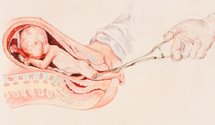The Fight Against Homosex—and Other Evils
 I’m not surprised that some culture warriors are disappointed with my recent article entitled “It’s Not the Homosex, Stupid.” The article didn’t make much of a splash but one or more outlets at least linked to it. Most of the feedback I have received has been positive, but discussion of “sterile sex” sharply divides the population into two camps and I must confess that only the smaller camp seemed impressed.
I’m not surprised that some culture warriors are disappointed with my recent article entitled “It’s Not the Homosex, Stupid.” The article didn’t make much of a splash but one or more outlets at least linked to it. Most of the feedback I have received has been positive, but discussion of “sterile sex” sharply divides the population into two camps and I must confess that only the smaller camp seemed impressed. But I am surprised that it elicited so few responses and so I conclude from that fact that either 1) there was sufficient merit to my argument to preclude a refutation or 2) it simply didn’t rate high enough in the interest department for readers to take the time to read, comment or respond. Who knows—given today’s levels of confusion and apathy—perhaps it was an odd combination of both.
For those who did read the article—thank you!—but who remain unconvinced and disappointed, I offer the following additional commentary, hoping it will prompt a careful re-read and maybe even trip the switch leading to the new paradigm shift in thinking which I maintained was necessary to make gains on the culture war.
I’ll start by expanding on the metaphor which I proposed in the article because in so doing it will likely have more punch than another 1500 words of similar argumentation on the subject.
Early in the piece I asked
“What would you think of drivers who ignored red lights but who regularly demonized speeding drivers as the real enemies on the road?”And then towards the end I summarized,
“It’s like trying to engineer more impact resistant cars rather than require drivers to stop at red lights. At this stage, it seems we have even forgotten the red light is there, or perhaps by now we have removed it entirely from the intersection.”
Let’s imagine an intersection where such an odd development actually took place. Imagine people started running the red light—for reasons which they thought were good at the time—and after a number of years more and more people were ignoring it. In the meantime, accidents at the intersection had started to increase but people’s habits and attitudes regarding the light had changed and it was rare to find anybody stopping any longer for the light. Practically nobody wanted to hear about or consider the role of that outdated red light.
In the meantime, a whole new subculture had been developing at this intersection. Ambulances and paramedics were more and more a frequent sight due to the crashes, injuries, and even deaths taking place there. The local newspaper had special reporters assigned to cover the happenings at the site and to tell the stories of the victims. Journalists from outside the city and the region were often writing on the phenomenon. Tow trucks were found parked as close as possible to the intersection in hopes of being the first to haul away the crumpled wrecks. Fire trucks were required to make scheduled passes of the intersection. There always seemed to be a crew of automotive engineers present from one major carmaker or the other, taking notes on how to make their cars more impact resistant in order to increase sales to the people in the area.
Over time, hundreds of people had found full time work—even a calling—to give themselves to saving lives and making a safer intersection. Countless theories and strategies were being offered and implemented to moderate the damage taking place at this notorious location. Sidewalks had been changed to protect pedestrians; signs saying “Be Careful” were posted everywhere; lighting at the intersection had been changed; etc., etc. Some blamed the media for their biased coverage of developments at the intersection; others said it was all caused by those who were speeding through the intersection; others blamed the increasing numbers of new—and foreign—residents to the area; many others attributed it to a societal breakdown in driving ethics and were busy trying to reform people’s thinking.
At some unknown stage, kids had noticed the strange looking red light peering down at them from the center of the intersection and had put out its eye with a well aimed stone. News reports had called for a crackdown on youth crime.
“Preposterous scenario!” the reader might exclaim.
Yes, I agree that it’s rather unbelievable, in the context of an intersection and a red light. What’s most unbelievable though is why people in the above city who had been actively engaged in helping the injured, consoling relatives of the dead, writing stories about the tragedies, re-engineering cars, moving sidewalks, posting signs, etc. were not screaming at the same time: “Something has to be done about this light! Everybody is ignoring it!”
When I point in my article to the disused and maligned red light, it is these very people—the ones most busily engaged in helping at the intersection, so to speak—who protest that criticism of their efforts is counter-productive to the common good. Usually, they cite the absolute necessity of continuing their work of vigilance, education and cleanup at the intersection and they miss entirely the point of getting the red light fixed. To them, I suspect, this suggestion is—in computer language—entirely un-processable. It’s impractical and sub-consciously dismissed because to them the red light is simply a relic of the past, an odd and ancient restriction of their right to drive on the road as they please—and as everyone else drives.
Some of the critics dismiss my point by claiming that the principal evil of running the red light is only one more evil in a long list of evils occurring at the intersection. They cite the evil and perversity of those who speed through the intersection because that’s what causes the most serious accidents. Others suggest they are fighting the evil misrepresentation by the media of the truth of what happens at the intersection. Others claim that in order to keep this kind of chaos from spreading to other parts of the city they’ve had to engage in the political process so as to promote laws to protect the innocent. These critics seem to be saying that since we’re all fighting various evils—but the same battle—I shouldn’t be zeroing in on the red light issue.
The argument about fighting various evils holds as much weight with me as claiming that the woman who is raped bears equal responsibility as the rapist because she happened to be dressed attractively. Perhaps it was provocative dress but the rapist is the one who committed a grave infraction of the law and who needs to be punished. Focusing on the woman’s behaviour without acknowledging and addressing the principal evil is totally irresponsible.
Perhaps there are better examples in this context but, similarly, the ones who run the red light [with impunity] are the ones committing the grave offense—according to the longstanding tradition and wisdom of Western civilization. It makes little sense to go after the woman in attractive dress or the speeders who are substantially ignorant of the purpose of the red light. Couldn’t we admit they have been conditioned by the longstanding behaviour of the good folks who have taken the liberty of altogether disobeying the injunction to stop for the light—and then setting up their own standard of carefully breezing through?
And besides, don’t we have a responsibility, insofar as possible, to trace evil to its roots and lay the axe to the root of the problem, not to its branches?
At the very least, shouldn’t the good folks who are tending to the challenges and tragedies daily unfolding at the intersection be consistently screaming “The light! The light! They’re running the red light! Someone needs to get a ticket!”
Bear in mind that the entire chaos taking place at this intersection, along with its attendant subculture, would disappear overnight if the red light were re-instituted.
That was my point and I made a case for it in the best way I could in short readable fashion. That’s all. If someone would like to refute my argument, fine. But to do so, we’ll have to get down to the particulars of the matter without gross misrepresentation of my thesis.
And I’m ready to respond to particulars.
Labels: contraception, culture wars


























0 Comments:
Post a Comment
<< Home